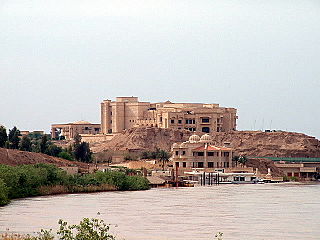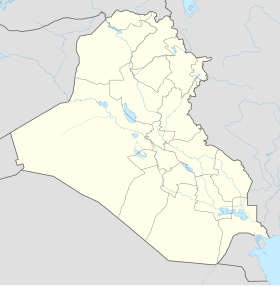
Tikrit is a city in Iraq, located 140 kilometers (87 mi) northwest of Baghdad and 220 kilometers (140 mi) southeast of Mosul on the Tigris River. It is the administrative center of the Saladin Governorate. As of 2012, it had a population of approximately 160,000.

The Islamic Army in Iraq was one of a number of underground Islamist militant organizations formed in Iraq following the 2003 invasion of Iraq by U.S.-led Coalition forces, and the subsequent collapse of the Ba'athist regime headed by Saddam Hussein. IAI was regarded as one of the largest, sophisticated and most influential Sunni insurgent groups in Iraq that led an asymmetrical military insurgency against Coalition forces. The group became known for its grisly videos of kidnappings and attacks on U.S. and Iraqi troops.
Events in the year 2005 in Iraq.

An Islamist insurgency is taking place in the Maghreb region of North Africa, followed on from the end of the Algerian Civil War in 2002. The Algerian militant group Salafist Group for Preaching and Combat (GSPC) allied itself with al-Qaeda to eventually become al-Qaeda in the Islamic Maghreb (AQIM). The Algerian and other Maghreb governments fighting the militants have worked with the United States and the United Kingdom since 2007, when Operation Enduring Freedom – Trans Sahara began.
The 2008 Nineveh campaign was a series of offensives and counter-attacks between insurgent and Coalition forces for control of the Nineveh Governorate in northern Iraq in early-to-mid-2008. Some fighting also occurred in the neighboring Kirkuk Governorate.
Events in the year 2010 in Iraq.
On 25 August 2010, a string of attacks in Iraqi cities including Al-Muqdadiya, Kut, Baghdad, Fallujah, Tikrit, Kerbala, Kirkuk, Basra, Ramadi, Dujail, Mosul and Iskandariyah targeting mostly Iraqi security forces and checkpoints left at least 53 people dead and more than 270 injured.

The Iraqi insurgency was an insurgency that began in late 2011 after the end of the Iraq War and the withdrawal of U.S. troops from Iraq, resulting in violent conflict with the central government, as well as low-level sectarian violence among Iraq's religious groups.
The 23 February 2012 Iraq attacks were the fifth simultaneous wave of bombings to hit Iraq during the insurgency and the first such major assault since the US withdrawal at the end of 2011. At least 83 people were killed and more than 250 wounded in highly coordinated attacks spread out in least 15 cities - including at least 10 explosions in the capital Baghdad that left 32 people dead. A number of shootings also took place, mostly aimed at police patrols and security installations around the city. The majority of the blasts appeared to specifically target Shiite areas.
The 20 March 2012 Iraq attacks were the sixth simultaneous wave of bombings to hit Iraq during the insurgency and the second such major assault since the US withdrawal at the end of 2011. At least 50 people were killed and around 250 wounded in highly coordinated attacks spread out in at least 10 cities. The deadliest attack of the day took place in Karbala where twin bombings left 13 dead and 50 injured. In the northern city of Kirkuk a car parked in the parking lot of a local security office exploded, killing 13 and leaving almost 60 wounded. Several explosions rocked the capital Baghdad, including mortar attacks close to the Green Zone and a suicide blast near an intelligence building opposite the Foreign Ministry – three people were killed and nine wounded in that attack. Numerous other bombings and shootings took place all across the country, including Fallujah, Samarra, Baiji, Hillah, Latifiya, Tuz Khormato and others. A car bomb in Ramadi killed two and injured 11, as unidentified gunmen shot and killed two police officers in a nearby village. Authorities in Baqubah discovered and successfully disarmed at least eight explosive devices.

The 2012–2013 Iraqi protests started on 21 December 2012 following a raid on the home of Sunni Finance Minister Rafi al-Issawi and the arrest of 10 of his bodyguards. Beginning in Fallujah, the protests afterwards spread throughout Sunni Arab parts of Iraq. The protests centered on the issue of the alleged sectarianism of Prime Minister Nouri al-Maliki. Pro-Maliki protests also took place throughout central and southern Iraq, where there is a Shia Arab majority. In April 2013, sectarian violence escalated after the 2013 Hawija clashes. The protests continued throughout 2013, and in December Maliki used security forces to forcefully close down the main protest camp in Ramadi, leaving at least ten gunmen and three policemen dead in the process.
The 2013 Hawija clashes relate to a series of violent attacks within Iraq, as part of the 2012–2013 Iraqi protests and Iraqi insurgency post-U.S. withdrawal. On 23 April, an army raid against a protest encampment in the city of Hawija, west of Kirkuk, led to dozens of civilian deaths and the involvement of several insurgent groups in organized action against the government, leading to fears of a return to a wide-scale Sunni–Shia conflict within the country. By 27 April, more than 300 people were reported killed and scores more injured in one of the worst outbreaks of violence since the U.S. withdrawal in December 2011.

Operation al-Shabah was launched in May 2013 by the Iraqi Army, with the stated aim of severing contact between the Islamic State of Iraq and the Levant and the al-Nusra Front in Syria by clearing militants from the border area with Syria and Jordan.
On 4 December 2013, a series of coordinated attacks took place in central and northern Iraq, with the biggest assault taking place at a government building and an adjacent shopping mall in Kirkuk. More than 30 people were killed in the attacks that day, while at least 106 were injured.

The First Battle of Tikrit was fought for the Iraqi city of Tikrit following the city's capture by the Islamic State and Ba'athist Loyalists during the 2014 Northern Iraq offensive. The battle took place between 26 and 30 June 2014.
The following lists events that happened during 2014 in Iraq.
The following lists events the happened in 2013 in Iraq.

The Timeline of the War in Iraq covers the War in Iraq, a war which erupted that lasted in Iraq from 2013 to 2017, during the first year of armed conflict.







